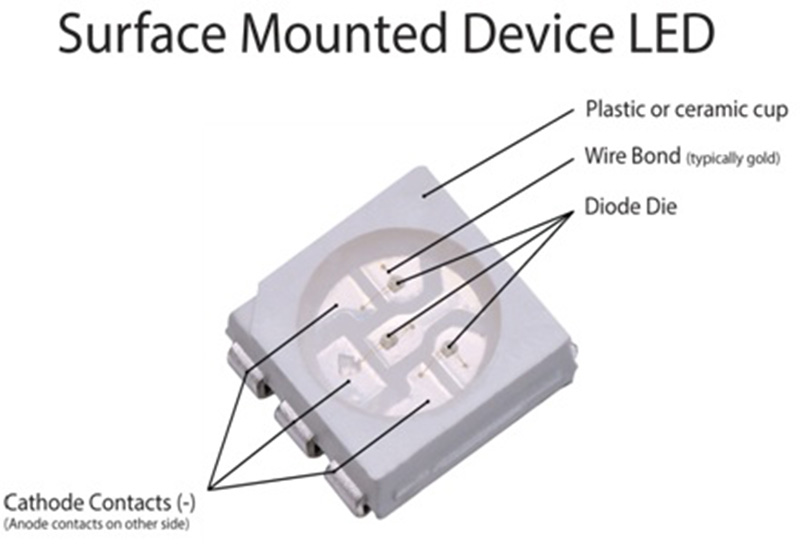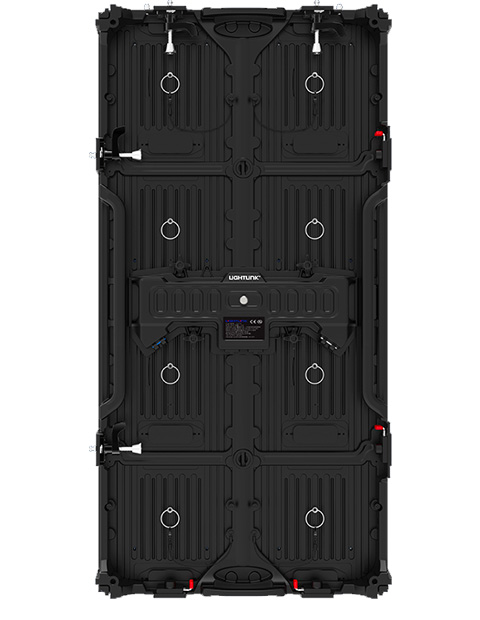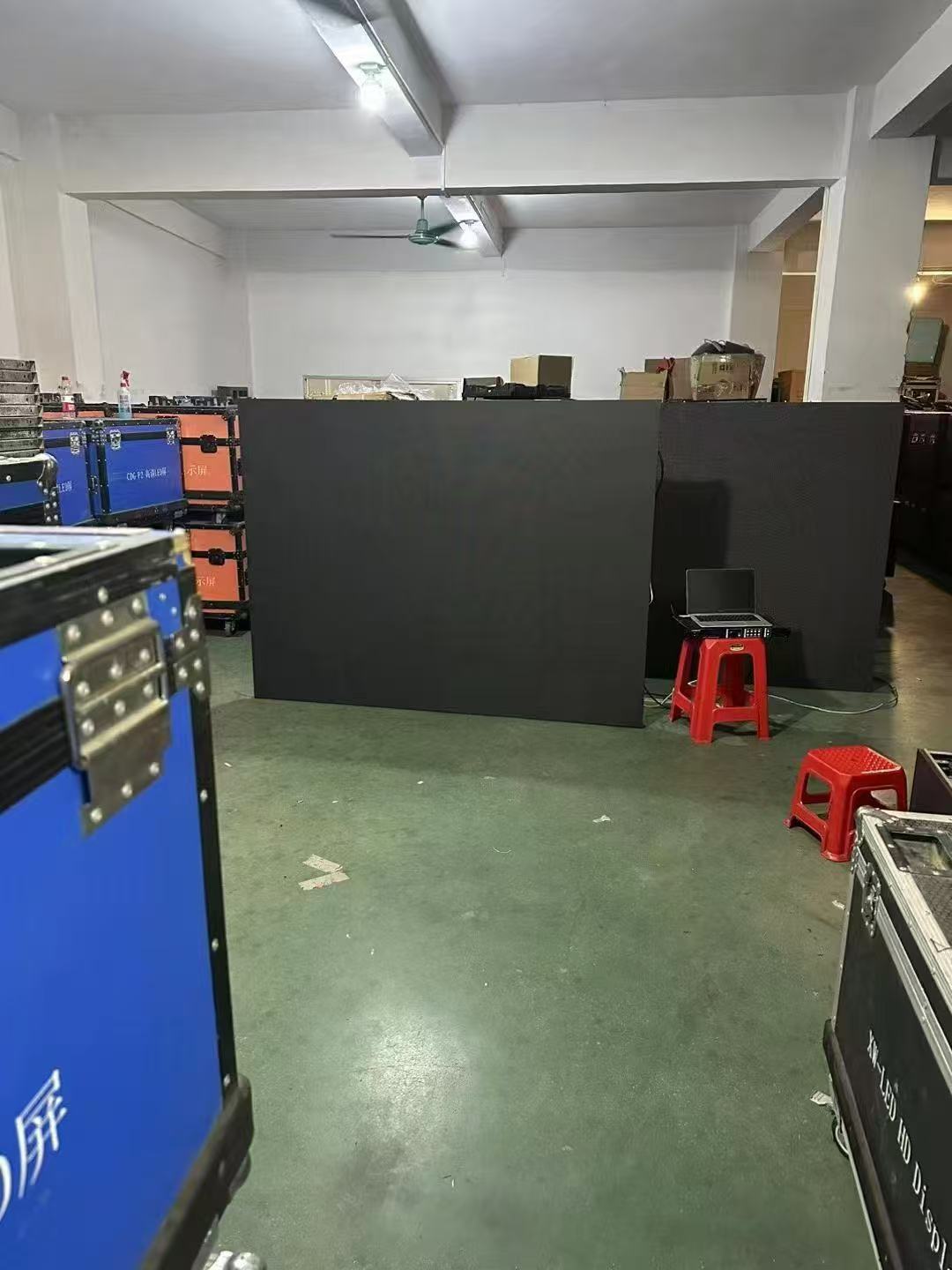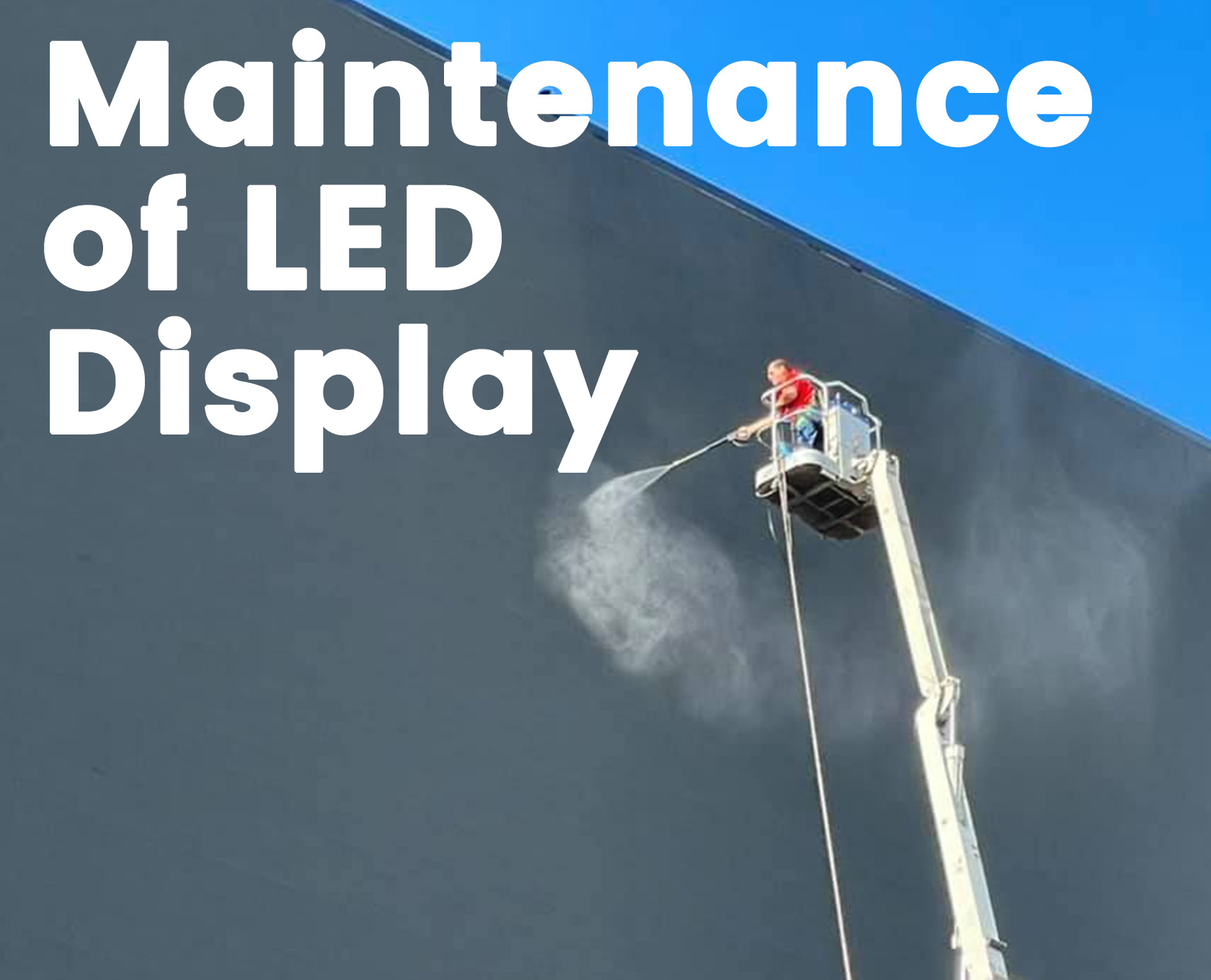This is a very interesting phenomenon in the LED display business. In the past, LED displays tended to use white LED packaging devices (white light), particularly in outdoor LED displays. In recent years, however, black LED packaging devices (black light) have also become more popular, particularly in the field of stage LED screens and small-pitch LED displays. What causes the light to turn black from white? Why are black LEDs preferred on small-pitch LED displays?
What is SMD LED package?

SMD (Surface Mounted Devices) refers to surface mount package structure LEDs, mainly including PCB board structure LEDs (ChipLED) and PLCC structure LEDs (TOP LED).
You can learn more about MIP, COB and SMD LED Technology
Composition of LED display device package
The main materials used in the packaging of LED display devices include brackets, chips, die-bonding adhesives, bonding wires, and packaging adhesives.
1.1 LED bracket
1) The role of bracket. The PLCC (Plastic Leaded Chip Carrier) bracket is the carrier of SMD LED devices and plays a key role in the reliability, light emission and other performance of LEDs.
2) The production process of stent. The production process of PLCC stent mainly includes metal strip stamping, electroplating, PPA (polyphthalamide) injection molding, bending, five-sided three-dimensional inkjet printing and other processes. Among them, electroplating, metal substrates, plastic materials, etc. are the main costs. 3) Structural improvement design of the bracket. Since the PPA and metal are physically combined in the PLCC retainer, the gap becomes larger after being exposed to an excessively high temperature reflow oven, causing water vapor to easily enter the device along the metal channel, thus affecting reliability.
In order to improve product reliability and meet the high-end market, some packaging manufacturers have improved the structural design of the retainer. For example, Nationstar LED has adopted advanced waterproof structural design, bending and stretching, etc.
They use extend the water vapor entry path of the bracket, and multiple waterproofing ways, such as waterproof grooves, waterproof steps, and drain holes are added inside the bracket. This design not only saves packaging cost, but also improves product reliability.
It has been widely used in outdoor LED display. The SAM (Scanning Acoustic Microscope) was used to test the air-tightness of the LED bracket with a curved structure design after packaging and the normal bracket. The results showed that the product with bent structure design has better air tightness.
1.2 Chip
The LED chip is the core of the LED device, and its reliability determines the life and luminous performance of the LED device and even the LED display. The cost of LED chips accounts for the largest proportion of the total cost of LED devices. As the cost decreases, the size of the LED chip becomes smaller and smaller, which also causes a series of reliability problems.
1.3 Bonding wire

Bonding wire is one of the key materials for LED packaging. Its function is to realize the electrical connection between the chip and the pins, and plays the role of introducing and exporting current between the chip and the outside world. Commonly used bonding wires for LED device packaging include gold wire, copper wire, palladium-plated copper wire, and alloy wire.
1) Gold wire. Gold wire is the most widely used and has the most mature technology, but it is expensive, resulting in high LED packaging cost.
(2) Copper wire. Copper wire has the advantages of cheapness, good heat dissipation effect, and slow growth of intermetallic compounds during the wire bonding process. The disadvantages are that copper is easily oxidized, has high hardness and high tensile strength.
Especially in the heating environment of the copper ball bonding process, the copper surface is easily oxidized, and the oxide film formed reduces the bonding performance of the copper wire, which places higher requirements on the process control during the actual production process.
3) Palladium-plated copper wire. In order to prevent oxidation of copper wire, palladium-plated bonding copper wire has gradually attracted the attention of the packaging industry. Palladium-plated bonding copper wire has the advantages of high mechanical strength, moderate hardness and good welding properties, and is very suitable for high-density multi-pin integrated circuit packaging.
More:
Gold Wire Vs. Copper Wire LED Displays
1.4 Adhesive
At present, the adhesives used for packaging LED display devices are mainly epoxy resin and silicone.
1) Epoxy resin. Epoxy resin is susceptible to aging, moisture, and poor heat resistance. It is also prone to discoloration under short-wave light and high temperature. It has a certain degree of toxicity in its colloidal state. The thermal stress does not match well with LEDs, which will affect the reliability and lifetime of LEDs. . Therefore, epoxy resins are usually attacked.
2) Silicone. Compared with epoxy resin, silicone has higher cost performance, excellent insulation, dielectric and adhesion properties. But the disadvantage is that it has poor air tightness and absorbs moisture easily. Therefore, it is rarely used in LED display packaging applications.
In addition, high-quality LED displays also have special requirements for display effects. Some LED packaging factories use additives to improve the adhesion of the adhesive and achieve a matte finish.
What is the meaning of “white” in white LED screens ?
High brightness: It is suitable to long-distance view
Understanding white light is necessary to understand black light LED displays. LEDs are made from chips and plastic brackets. Engineers made early chips not very bright. They made the brackets into white bowl shapes to increase focused reflection. This ensured that the low-brightness of the chip would achieve a brighter result. White light has its own shortcomings. The white light emitting diode is also the color that the display will use to express black or gray. This causes color distortion. ). Engineers compensate for a lack of brightness in the chip by reducing color expression.
LED displays have been used for outdoor advertising displays in the past. It is okay to sacrifice color in order to achieve the required brightness due to the large viewing distance. As LEDs become brighter and smaller, they no longer require white LED lamp beads to produce satisfactory results.
CREE, NICHIA, and other LED display packaging producers were the first to create black lamps to improve contrast and meet the needs of people. China’s LED display packaging company like Nationstar offers the darkest black among all products.
White LED Screens Features:
- Higher brightness: Offers a brightness level of 1800 cd/m², which is higher than that of black LED displays. This can be beneficial in environments with high ambient light.
- Higher Power Consumption: Consumes 410W/m², which is higher than black LED screens, indicating lower energy efficiency.
- Color distortion problems: The inherent color (white) of LEDs can contribute to color distortion when attempting to display blacks, grays, or dark greens due to the need to compensate for chip brightness limitations.
What is the meaning of “black” in Black light LED display ?

Richer colors and high contrast display
The higher the fidelity of an LED display, the better its performance. It is determined primarily by the color and contrast of the image. (The more colors the better, the greater the contrast).
Contrast refers to the measurement of different brightness levels between the brightest white and the darkest black in the light and dark areas of an image. The larger the difference range, the greater the contrast. The smaller the difference range, the smaller the contrast. High contrast is easier to display vivid, rich colors.
For example, an LED display’s brightness is 500cd/m2 in its full-white screen state and 0.5cd/m2 in the full-black screen state. Hence,The contrast ratio is 1000:1. LED displays that use Nationstar black light devices can currently increase contrast by 40%.
Related:
How to Select an Appropriate Brightness Level For LED Screens
Contrast is a critical factor in visual effects. In general, the higher the contrast the more clear and vibrant the colors and the better the clarity of the image. If the contrast is low, then the image appears gray. High contrast can be very useful for image clarity, grayscale expression, and detail expression.
High-contrast displays are better for text displays or video displays that have a large black-and white contrast. They also offer greater clarity and completeness. The contrast has a larger impact on the dynamic effects of video displays. The human eye can distinguish the conversion of dynamic images with greater ease if the transition between light and dark is relatively rapid.
The entire LED screen, which is made up of blacklight, can therefore present images with richer colors, deeper hues, and uniformity.
Colors that are non-reflective and more realistic
The black LED lamp bead is non-reflective, so it offers a high level of contrast. The PPA bracket of the black LED lamp is black. Because black is not reflective, light shines through the black bead and is converted to other energy, such as heat. The phenomenon of making colors clearer, more realistic and pure.
Due to the many colors of projection lighting in the stage environment the light and the shadow will be intertwined. This will affect the display of the LED stage screen. GDHANHENG uses surface atomization technology to diffuse the light so that LED displays using black devices are able to clearly see characters in a highly reflective stage environment.
The above characteristics of the black LED lamp beads allow for the avoidance of mutual interference between the light emitted from various light sources. This increases the black screen effect and does not depend on the brightness of external environments. LED displays using black lights will always maintain the brightness and darkness of the screen colors.
Black LED screens Features:
- Higher contrast ratio: Offers a contrast ratio of 10000:1, which is three times higher than white LED screens. This results in deeper blacks and a more vibrant overall image quality.
- Lower Power Consumption: Consumes 350W/m², making it more energy efficient than its white LED counterparts.
- Trend towards higher fidelity: Black LED screens are becoming more common in high-end displays, especially in markets such as the United States, Europe and Japan. This trend is driven by improvements in chip brightness and light efficiency, which allow for greater image realism without sacrificing contrast.
White light VS black light outdoor LED display: Which one Better?
Black light SMD LED displays are now the norm used for indoor displays, where high contrast is preferred to high brightness. For outdoor displays, however, many engineering companies, vendors and customers have always believed that higher brightness is better.
This kind of thinking has led to LED displays exceeding 5000cd in brightness. This will not only lead to light pollution and a loss of owner approval (the standard brightness for outdoor LED displays is 5 000CD and when outdoor LED displays exceed this standard, they are considered light pollution), but it will also reduce viewing enjoyment and harm the visual experience of consumers. It will increase the owner’s operating costs and electricity bill at the same.
Contrast is more important than brightness for image clarity
Does the LED display need to be that bright? In fact, according to the original source, the main reason for increasing the brightness of LED screens is to make screen images, videos, and other content more visible to consumers. According to research, the human eye is more sensitive to color than light or dark. Cone cells and columnar cell make up the retinal cells of the human eyes. Each cone cell is attached to an optical nerve ending. This allows for high resolution and can distinguish colors and details.
While multiple columnar cell are connected to the optic nerve ending so the resolution is very low and can only be distinguished by the outline of the image. The human eye has a very wide range of brightness perception. However, once the eye becomes accustomed to a particular brightness environment, the range of its perception is limited. The cone cells that are responsible for color perception play an important role at this time.
Contrast, which determines color brightness, is therefore more important than brightness when it comes to determining subjective clarity.
In general, the higher the contrast the clearer the image and the more vibrant and colorful colors. The lower the contrast the grayer the entire image, making it hard for the eye to differentiate. The contrast of dynamic video effects is more important than other aspects. The conversion between light and dark in dynamic images happens relatively quickly, so the higher the contrast the easier it will be for the eye to discern this conversion.
LED black light displays are more contrasty than white light products
In outdoor environments, increasing the contrast on the LED display is more practical than blindly going for high brightness, which can cause light pollution and excessive energy consumption. This will improve the recognition of the displayed image. The greater the contrast under the same brightness will result in a more vivid and layered image. This will give consumers a better viewing experience.
According to test results, black light contrast ratio for outdoor LED displays is approximately 3000:1, whereas the contrast ratio for white lights outdoors is approximately 1000:1 (due to the strong ambient light outside, the background brightness is higher in the outdoor white light LED display than the test environment). The relative contrast will be lower. The black light LED display with bracket cups in black plastic and PPA is more uniform on the screen, and it can absorb external light.
Black light LED displays are more competitive in the outdoor LED advertising industry, which is focusing on energy conservation, light environment and emission reduction.
Here’s a quick guide on the differences between black LED and white LED displays:
| Feature | Black LED Display | White LED Display |
|---|---|---|
| Contrast Ratio | 10000:1 | 3000:1 |
| Power Consumption | 350 W/m² | 410 W/m² |
| Brightness | 1500 cd/m² | 2000 cd/m² |
| Display Effect | High reduction for black or gray, more stable colors | Possible image distortion with black or gray, brighter colors |
| Cost | Higher | Lower due to strong price advantage despite weaker function |
Why Choose IAMLED black SMD LED screens

When you are looking for purchasing a high-quality rental LED screen, you can choose IAMLED’s black SMD LED screen. These outdoor rental LED screens offer a variety of unique benefits, including:
Better contrast than brightness:
Research shows that the human eye is more sensitive to changes in color than to changes in brightness, especially when the ambient brightness is relatively low. Our black SMD LEDs have a higher contrast ratio (typically 3000:1 compared to 1000:1 for standard white LEDs), making them more effective at delivering clear, vivid images, especially where background light intensity is variable. Enhanced contrast ensures clearer and more realistic images displayed on your black LED screen.
Enhance display effects under various lighting conditions:
Because Our black SMD LEDs have a lower background brightness, they maintain their display quality even under strong ambient lighting. For outdoor rental applications, LED screens are affected by direct sunlight or other strong light sources, so by minimizing the impact of external lighting, our black LED displays ensure consistent visibility and color accuracy.
Versatility for indoor and outdoor use:
Our black SMD LED displays also offer excellent visual performance at lower brightness levels, making them particularly suitable for indoor and outdoor applications. Traditional white-light LED displays, when used for indoor use, often suffer significant losses in grayscale fidelity and color accuracy due to the necessity to reduce brightness. In contrast, IAMLED black LEDs equipped with grayscale compensation technology can seamlessly adapt to different lighting environments without affecting display quality.
Energy efficiency and environmental considerations:
Our black LED displays have lower LED power consumption (350/m²) compared to white LED displays (410/m²), so you are choosing a more energy efficient and environmentally friendly option.
Reduce reflectivity and improve viewing experience:
For outdoor LED displays, we cannot control external light sources, which may reduce visibility. And black LEDs inherently reduce glare and reflections. Because the black PPA support frame used in our black LEDs absorbs rather than reflects light. This design helps reduce visual interference from stray light, ensuring colors maintain their original hue without distortion or blurring.
Conclusion:
Each product belongs to a specific era. The LED display screen field, with its demand for high definition and small spacing, belongs undoubtedly to the black light era.



